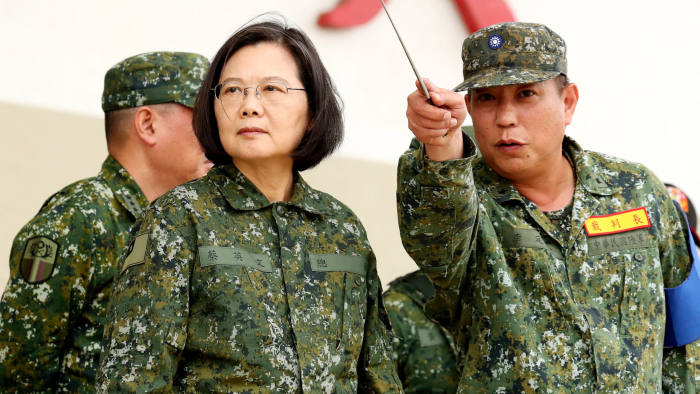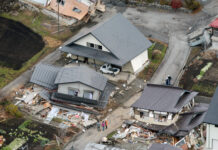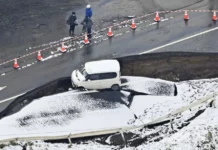HONG KONG: Taiwan has always been the Chinese Communist Party’s (CCP) highest strategic priority, yet Beijing has felt the need to deepen its coercion against the island nation. Indeed, a number of commentators are claiming the threat of a Chinese invasion, or military action of some kind, is higher now than it ever has been.
The ongoing border clashes along the Sino-Indian border in Eastern Ladakh represent a sideshow for the People’s Liberation Army’s (PLA), for the posture of China’s military is directed primarily against Taiwan and the threat of a US intervention on Taipei’s behalf.
Back in March, Enodo Economics, a macroeconomic and political forecasting company, assessed the probability of a conflict between China and the USA over Taiwan was 45 per cent sometime in 2020-22.
The US National Security Strategy document stated that “China … wants to shape a world antithetical to US values and interests. China seeks to displace the United States in the Indo-Pacific region, expand the reaches of its state-driven economic model, and reorder the region in its favor.” Central to its plans is to absorb and eliminate independent Taiwan, which would heal historical grievances, and solidify Chinese prestige and power at the expense of the USA.
China is certainly upping the ante in both words and actions. The PLA has intensified air and naval activity around Taiwan. The latter’s defense minister announced in early October that the PLA had conducted 49 aircraft sorties across the Taiwan Street median line this year, the highest number since 1990. Furthermore, the PLA has performed 1,710 aircraft sorties into Taiwan’s air defense identification zone this year so far, plus 1,029 naval sorties. Each time this occurs, the Taiwan military responds, adding a heavy operational and maintenance burden on its assets.
Collin Koh, Research Fellow at the Institute of Defence and Strategic Studies in Singapore, revealed, “In response to the PLA Navy ramped-up regular patrol presence west of the median line, Taiwan increased its presence from one to two ships too. However, Taiwanese defense authorities are concerned that even ‘older’ PLA Navy vessels are more capable than those the ROC Navy deploys.”
Koh said this “presence along the Taiwan Strait looks set to be a norm as Beijing clearly foresees regular transits through this waterway by foreign, especially US, military vessels. In the long term, the concern is that the ROC Navy would be outmatched by the PLA Navy in the Taiwan Strait as the latter replaces older ships with newer ones, bringing into question whether Taiwan’s naval shipbuilding program can react and cope effectively.”
In May, General Li Zuocheng, Chief of the PLA’s Joint Staff Department and a Central Military Commission member, promised, “If the possibility for peaceful reunification is lost, the people’s armed forces will, with the whole nation, including the people of Taiwan, take all necessary steps to resolutely smash any separatist plots or actions.”
He spoke on the occasion of the 15th anniversary of China’s Anti-Secession Law being promulgated, legislation that gives China a legal basis for military action against Taiwan. Of course, such a law has no international credence.
General Li added, “We do not promise to abandon the use of force, and reserve the option to take all necessary measures, to stabilise and control the situation in the Taiwan Strait.” It is in fact rare for a top Chinese general to explicitly make such a threat in public, which underscores the desperation that the CCP is feeling as Taiwanese sentiment hardens against China partly in response to greater suppression of dissent in Hong Kong.
Li Zhanshu, the CCP’s third-most-senior leader, said at the same event, “As long as there is a slightest chance of a peaceful resolution, we will put in hundred times the effort.” However, wielding a stick, “We warn Taiwan’s pro-independence and separatist forces sternly, the path of Taiwan independence leads to a dead end; any challenge to this law will be severely punished.”
Taiwan’s Mainland Affairs Council responded to such warmongering by saying, “Taiwan’s people will never choose dictatorship nor bow to violence. Force and unilateral decisions are not the way to resolve problems.” The office added that Taiwan has never been part of the People’s Republic of China. President Tsai Ing-wen is unbowed by Chinese threats, and she correctly states that Taiwan is already an independent country called the Republic of China.
Derek Grossman, senior analyst at the RAND Corporation, tweeted, “Time to face facts. China’s peaceful ‘reunification’ strategy for Taiwan has failed. No need to continue the politeness, the subtlety. ‘One Country, Two Systems’ has been roundly rejected in Taiwan – even by KMT [Kuomintang]! – & now coercion is all that’s left. Sad.”
China has delineated those circumstances “requiring” an armed intervention against Taiwan: formal declaration of Taiwanese independence; undefined moves towards independence; internal unrest; acquisition of nuclear weapons; indefinite delays in cross-strait dialogue; foreign intervention; or foreign forces stationed on Taiwan.
In January 2019, Chairman Xi Jinping reiterated China’s long-standing stance on refusing to renounce the possibility of force, and reaffirmed unification under “one country, two systems”, something that proved a disaster for Hong Kong.
China’s options are not binary though: to invade or to not invade. Instead, it has a wide range of options to stir and pressurize. It could use missiles, destroy Taiwanese infrastructure and use cyberattacks to force Taiwan to sue for peace, for example. Yet 58 per cent of Taiwanese are still “not worried at all” about the risk of war with China according to an August poll.
At the moment Beijing is aggressively posturing and signaling. The 2020 Chinese military report by the Pentagon stated: “The PLA could also conduct a more comprehensive campaign designed to force Taiwan to capitulate to unification, or unification dialogue under China’s terms. Notably, China would seek to deter potential US intervention in any Taiwan contingency campaign … Failing that, China would attempt to delay and defeat intervention in an asymmetric limited war of short duration. In the event of a protracted conflict, China might choose to escalate cyberspace, space or nuclear activities in an attempt to end the conflict, or it might choose to fight to a stalemate and pursue a political settlement.”
The Pentagon lists the following military options that China has against Taiwan: an air and maritime blockade, which could be accompanied by missile attacks and seizure of outlying Taiwanese islands; limited force or coercive options, which could include information operations, limited kinetic attacks, assassination of leaders or computer network manipulation; air and missile campaigns against military targets to degrade defenses; and finally an outright invasion.
Regarding the latter, the Pentagon assessed, “An attempt to invade Taiwan would likely strain China’s armed forces and invite international intervention. These stresses, combined with China’s combat force attrition and the complexity of urban warfare and counterinsurgency, even assuming a successful landing and breakout, make an amphibious invasion of Taiwan a significant political and military risk.”
Indeed, China would have only one shot at an invasion, so Xi would not move too early if he deems the PLA is not ready. China would rely on a huge fleet of civilian ships to move troops and equipment across the Taiwan Strait, with a 2017 analysis estimating civilian ferries and ships could move about 150,000 troops. However, these require port facilities, of which there are really only 3-4 worthwhile ones in Taiwan.
Taiwan’s geography is not conducive to invasion either. Two-thirds of the island is mountainous, and large stretches of its coastline are unsuitable for invasion. That leaves a limited number of possible invasion beaches in the north and southwest coast. Unfortunately, Taiwan’s military would be outclassed in a straight fight, so it cannot allow a landing to occur.
The Pentagon went on to note, “China could launch an invasion of small Taiwan-occupied islands in the South China Sea such as Pratas or Itu Aba. A PLA invasion of a medium-sized, better-defended island such as Matsu or Jinmen is within China’s capabilities. Such an invasion would demonstrate military capability, political resolve and achieve tangible territorial gain while simultaneously showing some measure of restraint. However, this kind of operation involves significant, and possibly prohibitive, political risk because it could galvanize pro-independence sentiment on Taiwan and generate international opposition.”
Ian Easton, Research Fellow at the Project 2049 institute, has been persistently warning of the danger to Taiwan. He wrote in 2018: “Beijing has repeatedly evinced a willingness to risk breaking the peace. While China’s aggressive actions in the South China Sea are disquieting, its continuing provocations against Taiwan portend something far more ominous. It should be clear that China’s aim is not the maintenance of the ‘status quo’, but rather the forcible annexation of Taiwan, even at the risk of great power war.”
However, not every analyst believes war is imminent. Adam Ni, cofounder of the Neican newsletter, assessed the possibility of a Chinese invasion as follows: “I do NOT believe there is appetite among Chinese leaders for war over Taiwan in the near term, despite the hardcore rhetoric and the PLA’s show of force. But the chances of war have gone up, definitely, mainly due to rising possibility of accidents. I think the odds of full war over Taiwan through 2022 are around 5%. Odds of some kind of kinetic incident (short of war) is much higher, probably 20%.”
“For the CCP/PLA, total war (e.g. invasion) is an annihilative strategy. No political conditions, just imposing its will on a vanquished population. Coercive courses of action are much more likely. We see it every day. Even if only a 5% chance, annihilation must be a basis for planning.”
The danger is that Xi’s regime has been so vocal about the Taiwan issue that it can no longer afford not to act.
The USA relies on “strategic ambiguity” on whether it would intervene in a China-Taiwan conflict. However, given the PLA’s rapid modernization, old US assumptions about the US-China-Taiwan dynamic are badly out of date. China believes it is still in a civil war, with the hypothetical notion of one day reunifying Taiwan. Yet the USA engaging in an open-ended war with another nuclear power is a frightful specter. But then again, so is abandoning a democracy to the hands of a communist aggressor. What would such neglect say to other Asian allies of the USA?
President Donald Trump has shown more support for Taiwan than his predecessor did, but some are even advocating that the USA restore full diplomatic relations. Japan would be torn between staying out of any Sino-US conflict, but at risk of damaging its relationship with the USA, upon whom it relies for defense. It could thus limit support to logistics and basing only, for example.
China could use any tensions between the USA and North Korea to its advantage. Indeed, Taiwan-based academic J. Michael Cole wrote, “I would argue that a decision to launch military strikes against North Korea would represent the most dangerous period for Taiwan’s survival, as this could prompt Beijing to seize the opportunity created by the American focus on North Korea to resolve its historical grievance.”
A two-front war for the USA in Asia would represent a stiff challenge, with US lines of communication longer to Taiwan than they are to the Korean Peninsula. However, if Taiwan were to fall to China, it would free up an incredible amount of Chinese resources – financial, military, manpower and political – to cause trouble elsewhere.
Taiwan is thus a critical bastion against Chinese expansionism. One can imagine that if China occupied Taiwan, the PLA would have free access to the Western Pacific for its warships, submarines and aircraft. Furthermore, the First Island Chain containment would be smashed to smithereens, with the PLA controlling the central linchpin of the First Island Chain, with Japan and the Philippines then at considerable risk.
Taiwan is pivotal to Chinese national policy and prestige. It is also critical to American and allied defense in the Western Pacific. This democratic island is thus worthy of support by those who are concerned about the CCP’s military and territorial ambitions. (ANI)







